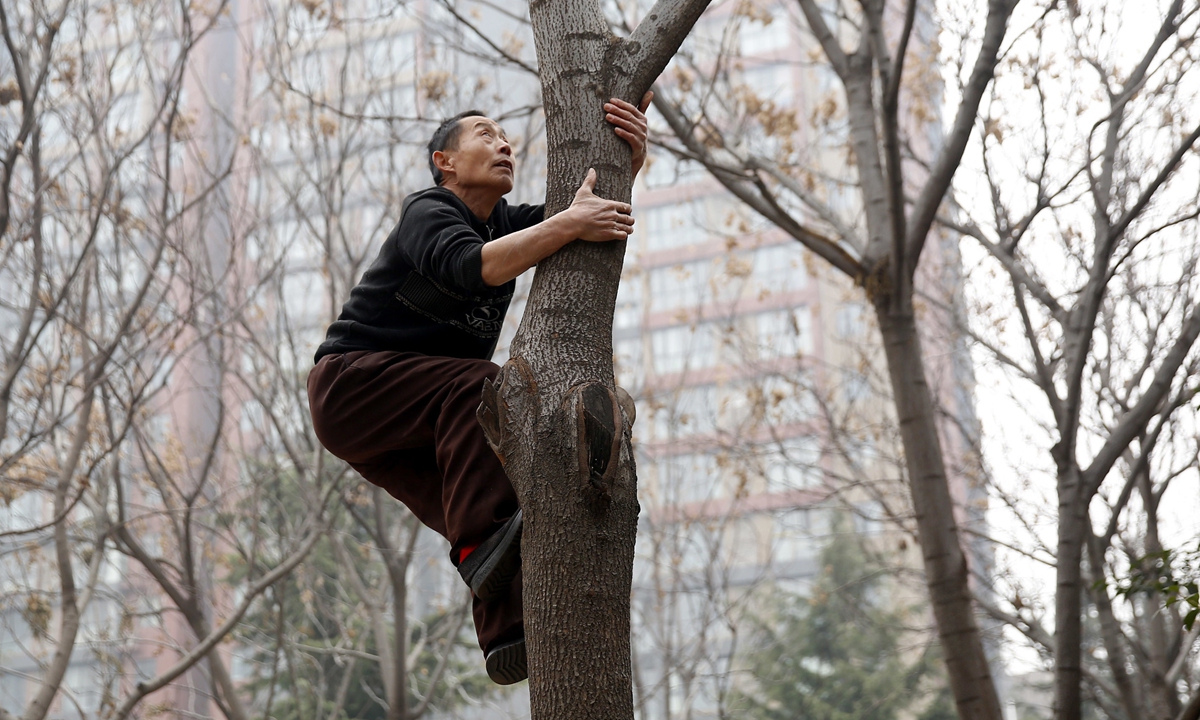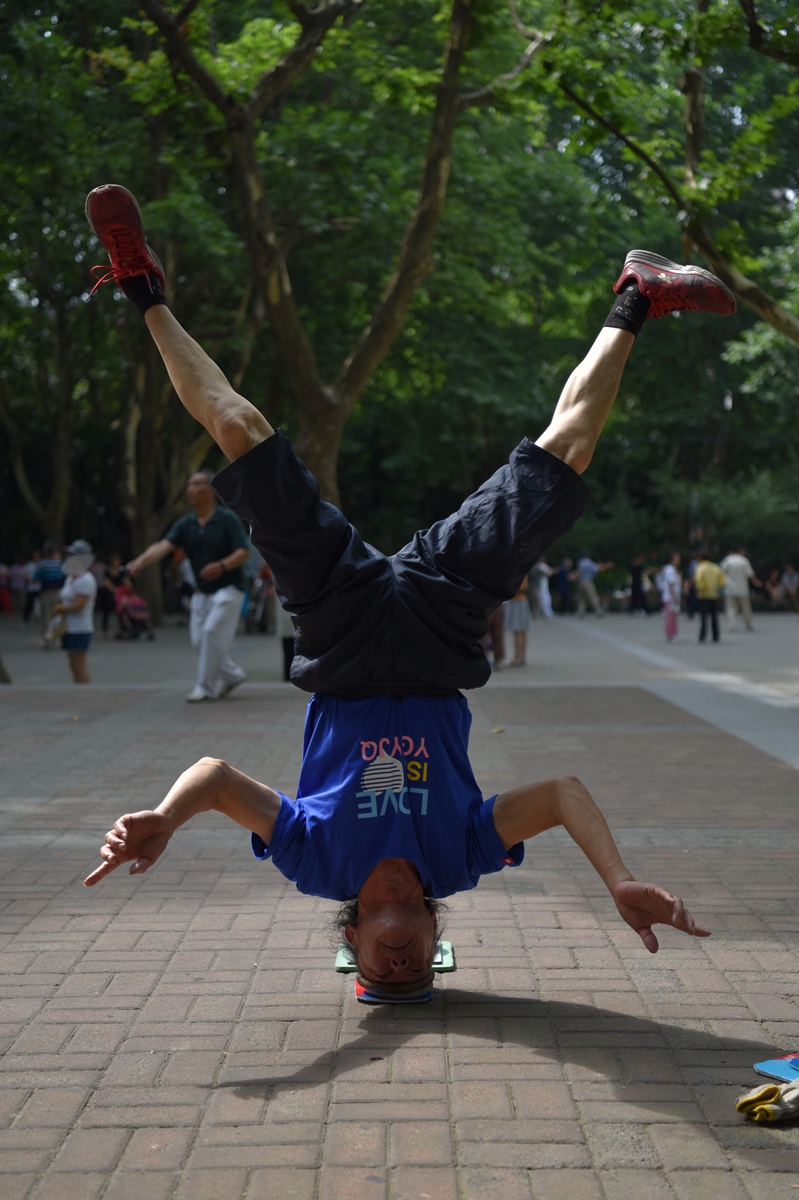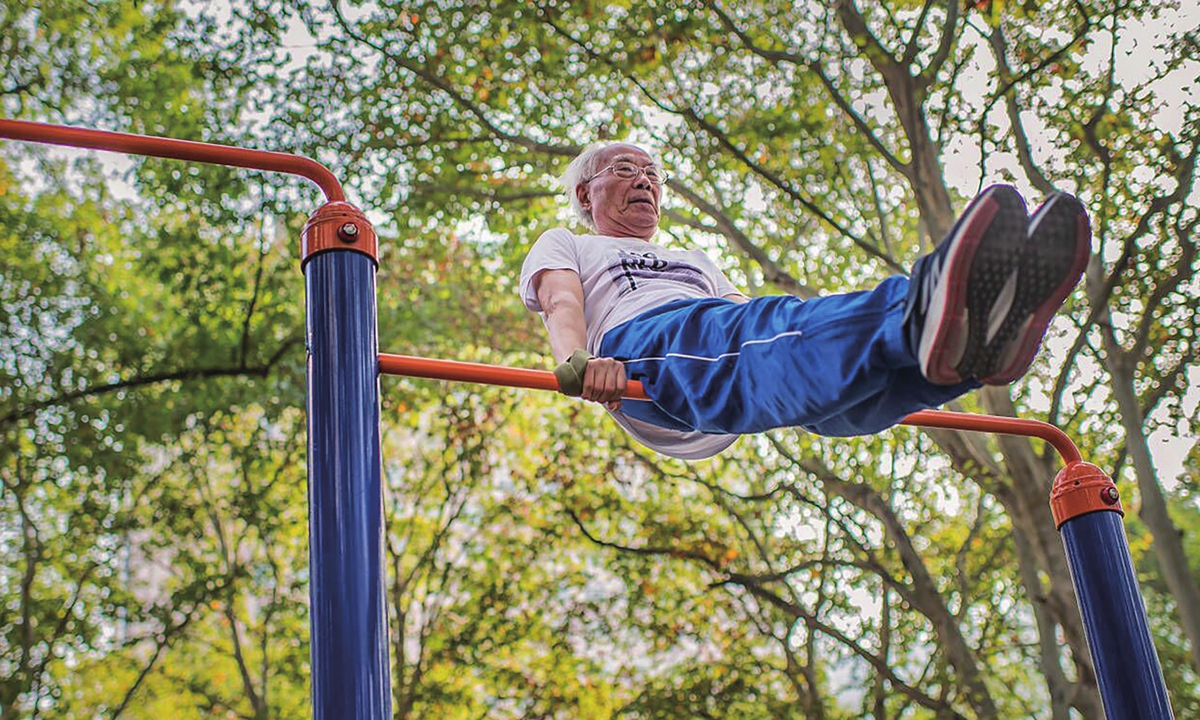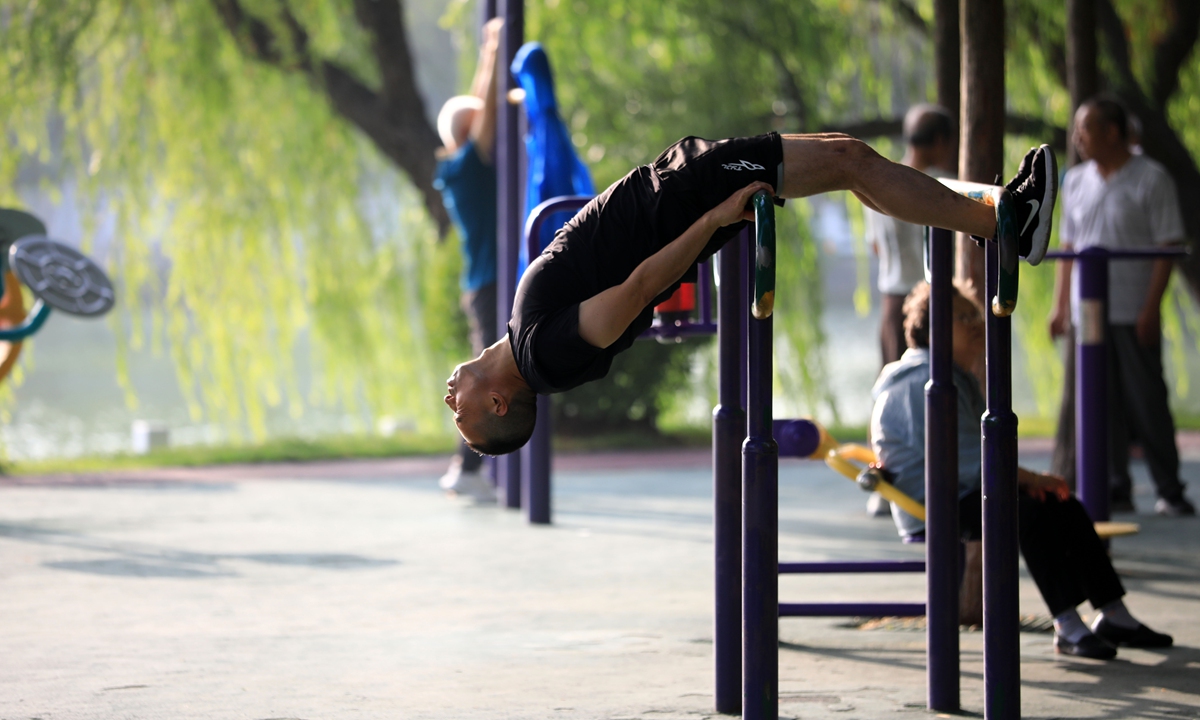ARTS / CULTURE & LEISURE
Elderly in China engage in bizarre fitness trends, posing safety risks
Exercise caution

Senior people exercise in "wild" ways. Photo: VCG
In recent years, a fitness trend dubbed "hanging neck exercise" among Chinese senior citizens has gained popularity. Executed by fixing a rope-like neck-hanging sling to a high tree branch or fitness equipment, one hangs by his head allowing his body to swing with the rope. Those who partake in this new fitness craze believe that it is very helpful for their cervical spine and back.Meanwhile, a man in his 50s tragically died while attempting to execute the exercise move, sparking increased scrutiny of this "fitness" method. It was reported that he had adopted the practice after seeing it demonstrated online, but it took a fatal turn after he exerted excessive force during his attempt.
At Beijing's Temple of Heaven Park, the neck-hanging exercise was once prevalent. Wen, a regular at the park, recounted how several trees used to host participants "training their necks," but this activity was eventually prohibited following a safety incident. "Back then, many believed this exercise could effectively alleviate neck problems and even prevent cervical spondylosis," he said.
Although the Temple of Heaven Park no longer permits the neck-hanging exercise, many senior citizens continue to experiment with similar methods in community parks and elsewhere, driven by a desire to find effective neck care techniques.
This peculiar swinging neck exercise was pioneered by Sun Rongchun, a resident of Shenyang, Liaoning Province, in Northeast China, several years ago to alleviate neck pain. Pleased with the results, the 57-year-old began recommending it to others, thus sparking a controversial fitness craze among senior enthusiasts. Subsequently, various strange exercise methods have emerged among the senior fitness community.
In addition to neck-hanging, other unconventional exercises like crawling and head-butting trees have become popular in parks. The daring movements resemble professional acrobatic performances, earning nicknames like the "morning exercises of the gods" on social media platforms.

Senior people exercise in "wild" ways. Photo: VCG
Wild waysMany senior citizens favor these unconventional fitness methods for their variety and hardcore nature. Besides neck-hanging, head-butting trees, and crawling on all fours, performing 360-degree loops while hanging from a bar has also become increasingly popular. Some even go to the extreme of striking their groins with metal implements, purportedly to enhance resilience and endurance.
The practice of tree-bumping, for instance, involves senior citizens courageously colliding with tree trunks, iron poles, or marble walls in parks. There's also tree-patting, during which hitting tree trunks with one's hands is believed to have fitness benefits. Despite appearing painful, these exercises are believed to treat cervical spondylosis by participants.
Wen said the versatility of these fitness methods, highlighting the crawling exercises as integral to overall fitness. Crawling slowly like a turtle strengthens the back, while moving like a bear with coordinated limb movements enhances limb dexterity. Lizard-like prone crawling targets abdominal and lumbar strength, and the monkey-like jumping crawl provides overall muscle conditioning and cardio benefits.
"These crawling methods may seem odd to many, but each offers distinct fitness benefits. While some find our exercises strange, they prove beneficial with persistence, making us feel younger and more energetic," said Wen.
The trend of foot-bound horizontal large-loop bar 360-degree turns has also gained popularity among senior fitness groups in recent years. Once, a septuagenarian in Beijing's Ditan Park accidentally bumped into a young girl while performing the large loop exercise with his feet tied to a horizontal bar, launching her into the air. Many consider such fitness methods highly dangerous and even potentially fatal, yet an increasing number of retired people view them as therapeutic exercises for back pain relief. They believe such activities alleviate neck and shoulder pain and other conditions.

Senior people exercise in "wild" ways. Photo: VCG
Scientific explanationPhysical therapist and personal fitness instructor Luo Chaofan told the Global Times that despite their apparent effectiveness, these "wild" fitness methods pose significant safety risks. He urged senior citizens to exercise caution when choosing fitness activities, advising them to avoid blindly following trends, and prioritize personal safety.
Taking the neck-hanging exercise as an example, Luo pointed out that the human neck can withstand a maximum weight of 25 kilograms, far below the weight exerted by the neck-hanging exercise. Sustaining several times this weight for extended periods while moving the body in different directions is highly unsafe.
"This habit has cured my spinal problems. I no longer need medication," claimed an elderly woman who hangs for at least 30 minutes, on social media. "I can even take a little nap while hanging; it's so comfortable."
"Hanging neck exercises are said to stretch the cervical spine and vertebrae, relieving nerve pressure, but these claims lack scientific proof. Moreover, such exercises can lead to severe spinal injuries, even paralysis," Luo said.

Senior people exercise in "wild" ways. Photo: VCG
People believe that senior citizens are drawn to crawling exercises because they are gentle and soothing, mobilizing various body systems during execution. Crawling can prevent and alleviate various age-related ailments, protecting seniors from injury during fitness activities. However, caution should be exercised to protect the knees while crawling.When engaging in fitness activities in public spaces, senior citizens should pay special attention to their personal and collective safety. Assessing one's range of movement and yielding to pedestrians when using fitness equipment are essential practices.
Luo emphasized that the primary goal of senior fitness is health, thus safety and injury prevention should be paramount. Maintaining an optimistic mindset, regardless of one's physical condition, is crucial to maintaining a fitness regimen. Consistently adhering to a well-structured plan is key to enjoying the benefits of exercise while staying healthy.
"For senior citizens, recommended exercises such as swimming, jogging, walking, and cycling are highly beneficial for cardiovascular health. Engaging in these activities 3 to 5 times a week for 30 to 60 minutes each time, with intensity ranging from mild to moderate, can increase the heart rate by 40 percent to 85 percent. Senior citizens with pre-existing cardiovascular conditions should exercise caution to prevent accidents," Luo concluded.



